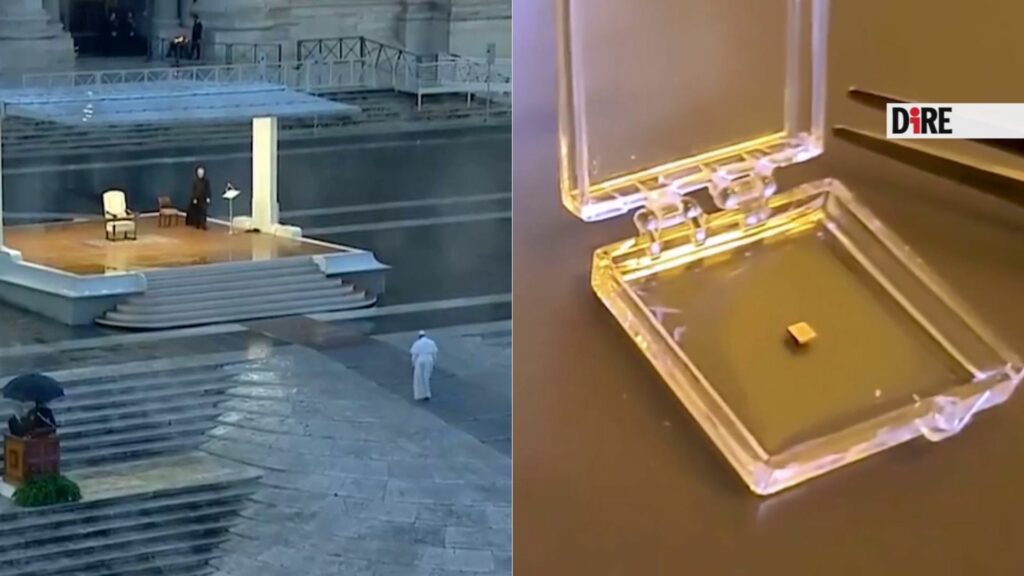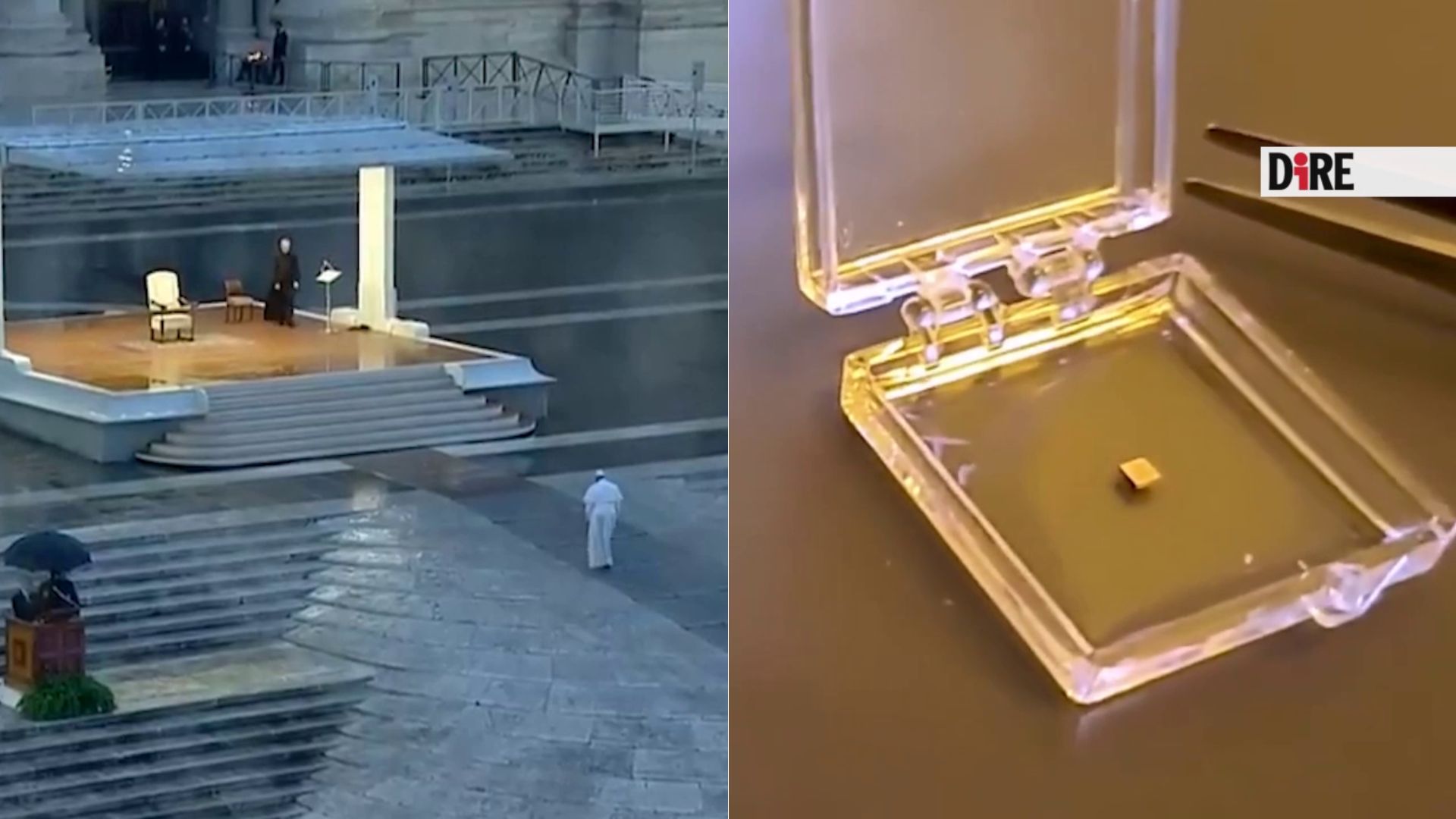
Rome – at first small, then dwarfed by the thrust of technology which, for once, placed itself at the service of faith. Let’s talk about Pope Francis and the Statu Orbis prayer attached A nanobook created by Cnr and about to fly into spacewith satellite cubes It will take off on June 10, 2023 from California. Statio Orbis was announced on March 27, 2020, in the midst of the pandemic, in Saint Peter’s Square deserted in the rain: a bleak moment for humanity, in which the Pontiff sheds light with words of hope. A miniature book containing the prayer has been deposited in the Seed Bank in Svalbard, a symbolic gesture that is now taking a step forward thanks to the creation of a nanobook bound for Earth orbit. A small square of gold-plated silicon, 2 millimeters on each side and a few tenths of a millimeter thick It was developed by Italian researchers. We talked about it with Andrea Notargiacomo, a researcher in the Institute of Photonics and Nanotechnology at Cnr.
The nanobook is in the facts Silicon polished surface, dark in color, in which holes and notches were made. Not with pins, but with processes typically used in micro and nanoelectronics. Very complex processes are used that allow starting from the design, from the drawing initially reported by the computer – since all the processes use equipment, there is nothing manual. The content that appears if we want to visualize the surface of a book is basically 9 cells, 9 half-millimeter regions on each side, 8 of which contain a series of very small holes that we have called nanoholes (they are about one-thousandth the diameter of a hair). To give an idea of how big the smallest things are on the surface – Notargiacomo explains – we’re about 100-130 nanometers across. A nanometer is one billionth of a meter. To make it easier to perceive, we denote a hair, which is about a tenth of a millimeter thick, and thus we make up one-thousandth of the diameter of a hair: this means that on the surface of the hair we can, in thickness, write between 1000 and 1005 points which are those in the book.
Also Read: Captivity Satell, Pope Francis in Space With Nanotechnology Jewel
“The remainder of the surface of the book contains another cell where the drawings have migrated. There is the symbol of the Pope: this is something we wanted to include because it gives us the idea that we can recover the information that we have written in the nanobook, that is, to relate the sequence of holes and empty spaces, such as if it is Braille writing, meaning cipher writing.In our case there is a whole series of flat spaces and perforated spaces. This type of nano-punch card can be re-read using high-resolution microscopy techniques. With this kind of encryption key that we have entered, it is possible to recover all the information. We have taken back some letters of the alphabet, in particular the title of the book, and reproduced them in terms of nanoholes and elements of binary language, that is, in a sequence of zeros and ones. Because in fact, the nanoholes we made correspond to the holes in the bilingual and in correspondence to all 0 we have the planar. This was the strategy to reproduce the information on the nanobook.”
The researchers also met Pope Francis during an audience. “It was a really emotional moment. We ourselves contributed to the realization of this initiative. There is not only a nanobook, but also a small satellite measuring 10 x 10 x 30 cm which seems to me, since I don’t make satellites, something extraordinary.” Indeed, and for them what we did as CNR was exceptional, and I must say that all of us meeting the Holy Father was an emotion. The final recognition of something that already seemed to us in the course of its implementation was a very valuable initiative, because it was not just doing something on a practical level on the surface A small piece of silicon, but it was a sense behind this 2 mm object, Crumbs have something more in them because they contain a message that can be retrievedIt has an intrinsic meaning. Not only is there the technological difficulty of creating something significant, there was really the awareness of doing something more and having the Pope close to us to see what we’ve achieved was a great emotion.”
What is the most commonly used nanofabrication technology? “The techniques are varied and disparate. They are called lithographic techniques, that is, those that are used to create structures on materials, but they are not thought frivolously as chiseling: layers of polymers that can be sensitive to ultraviolet light, or to electrons, are used, and there are machines that carry beams of electrons or ultraviolet light on the substrates, so with proper masks and repeated operations it is possible to obtain large structures of centimeters, even millimeters, even microns and then even nanometers.By combining all these tools and many more processes that are then used to deposit metals Or other kinds of materials, we create the devices.Any examples? Electronic devices that can be used as light sensors. Let’s think of a UV dosimeter we can wear on our bodies and measure how much we’re exposing ourselves to the sun’s rays; They can also be sensors used in the biomedical field, for example covid sensors can be manufactured; Again, the devices used in photonics, that is, the transmission of information through light, not through electronics. As an institute, we extend in really disparate fields, today interdisciplinarity in the scientific field is very important and can offer a lot, and it can be very important in producing something new. The fact that we already had experience with nanotechnologies was the element that made us strengthen contact with Monsignor Ruiz to continue our nanobook activities.”
The mission that will bring the nanobook into orbit is called Spei satelles and has been promoted by the Holy See, with support from the Italian Space Agency (ASI).
The news on the Dire website can be used and reproduced, provided that the source Agenzia DIRE and the address www.dire.it are expressly mentioned.

“Infuriatingly humble alcohol fanatic. Unapologetic beer practitioner. Analyst.”


